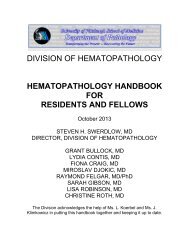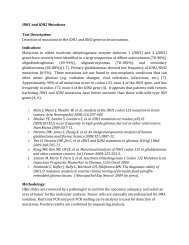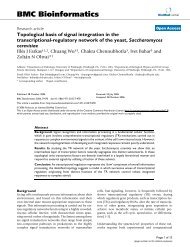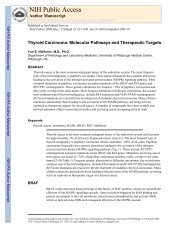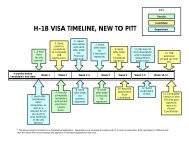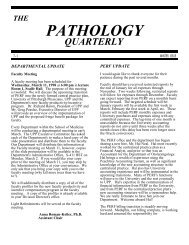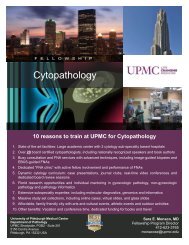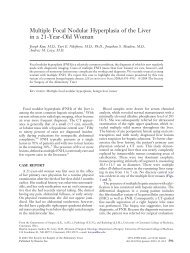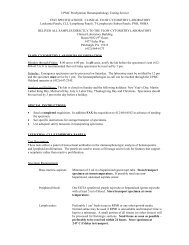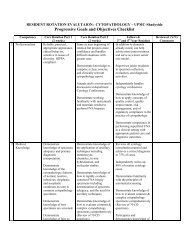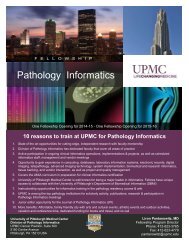Oncogenic AKAP9-BRAF fusion is a novel mechanism of MAPK ...
Oncogenic AKAP9-BRAF fusion is a novel mechanism of MAPK ...
Oncogenic AKAP9-BRAF fusion is a novel mechanism of MAPK ...
You also want an ePaper? Increase the reach of your titles
YUMPU automatically turns print PDFs into web optimized ePapers that Google loves.
esearch article<br />
Figure 6<br />
Detection <strong>of</strong> V600E <strong>BRAF</strong> mutation cDNA from post-Chernobyl tumors<br />
that developed 9–12 years after exposure using LightCycler real-time<br />
PCR followed by fluorescence melting curve analys<strong>is</strong>. (A) Real-time<br />
amplification <strong>of</strong> cDNA samples. (B) Detection <strong>of</strong> point mutations by<br />
the postamplification fluorescence melting curve analys<strong>is</strong> based on<br />
a d<strong>is</strong>tinct melting temperature <strong>of</strong> duplexes formed between the WT<br />
probe and either WT (62.8°C) or mutant (57.0°C) sequences. The<br />
mutations in both samples are heterozygous, since both mutant and<br />
WT peaks are detectable.<br />
intracellular effectors along the <strong>MAPK</strong> pathway have been previously<br />
implicated in human carcinogenes<strong>is</strong> through mechan<strong>is</strong>ms other than<br />
point mutation. In the present study, we demonstrate <strong>BRAF</strong> activation<br />
by chromosomal rearrangement that results in <strong>BRAF</strong> <strong>fusion</strong> to<br />
the <strong>AKAP9</strong> gene in thyroid papillary carcinomas. The <strong>fusion</strong> protein<br />
lacks the regulatory domains <strong>of</strong> <strong>BRAF</strong>, which results in constitutive<br />
kinase activation in a RAS-independent manner, and exhibits transforming<br />
activity similar to that <strong>of</strong> the most common <strong>BRAF</strong> V600E .<br />
The <strong>fusion</strong> partner <strong>of</strong> <strong>BRAF</strong>, the <strong>AKAP9</strong> gene, belongs to the<br />
group <strong>of</strong> A-kinase anchor proteins that have the common function<br />
<strong>of</strong> binding to the regulatory subunit <strong>of</strong> PKA and targeting<br />
it to d<strong>is</strong>crete locations within the cell (29). <strong>AKAP9</strong>, in particular,<br />
has predominantly centrosomal and Golgi compartmentalization<br />
(19–21). The <strong>fusion</strong> protein lacks the C-terminal centrosomal<br />
domain and, as expected, loses its centrosomal localization<br />
in cancer cells. Moreover, immunoh<strong>is</strong>tochemical analys<strong>is</strong><br />
with <strong>AKAP9</strong> antibody revealed no evidence <strong>of</strong> wild-type <strong>AKAP9</strong><br />
within centrosomes <strong>of</strong> cancer cells in all cases positive for the<br />
<strong>fusion</strong> by RT-PCR. Th<strong>is</strong> may suggest the competitive inhibition<br />
<strong>of</strong> wild-type <strong>AKAP9</strong> by <strong>AKAP9</strong>-<strong>BRAF</strong>, although further studies<br />
are required to confirm th<strong>is</strong>. <strong>AKAP9</strong> <strong>is</strong> an important regulator<br />
<strong>of</strong> c-AMP–dependent PKA and interacts with many other<br />
signaling proteins, including serine/threonine kinase protein<br />
kinase N, protein phosphatase 1, protein phosphatase 2A, and<br />
PKC-ε (20, 30). Thus, deregulation <strong>of</strong> its function in cells harboring<br />
<strong>AKAP9</strong>-<strong>BRAF</strong> <strong>fusion</strong> may affect a variety <strong>of</strong> physiological<br />
functions. On the other hand, neither <strong>AKAP9</strong> nor other AKAP<br />
genes have been implicated in carcinogenes<strong>is</strong> so far. Therefore,<br />
it remains unclear whether or not the <strong>AKAP9</strong> portion <strong>of</strong> the<br />
<strong>fusion</strong> gene contributes independently to its transforming<br />
potential, besides providing an active promoter driving the<br />
expression <strong>of</strong> truncated <strong>BRAF</strong>.<br />
Over the last decade, it has become apparent that activation<br />
<strong>of</strong> components <strong>of</strong> the <strong>MAPK</strong> pathway in thyroid cancer can be<br />
achieved through several d<strong>is</strong>tinct genetic events, i.e., RET/PTC<br />
(or, less frequently, TRK) rearrangements, RAS point mutations,<br />
or <strong>BRAF</strong> point mutations. However, the relative frequency <strong>of</strong> each<br />
event varies significantly in different populations. <strong>BRAF</strong> point<br />
mutation <strong>is</strong> the most common change in sporadic adult papillary<br />
carcinomas. In contrast, tumors associated with accidental or<br />
therapeutic irradiation have exceedingly high frequency <strong>of</strong> RET/<br />
PTC rearrangements and absence or low prevalence <strong>of</strong> <strong>BRAF</strong> point<br />
mutations (31–38). The 2 most common RET/PTC types found in<br />
up to 80% <strong>of</strong> radiation-associated tumors, RET/PTC1 and RET/<br />
PTC3, are both paracentric inversions <strong>of</strong> chromosome 10q (39, 40).<br />
Another rearrangement, which contributes to about 7% <strong>of</strong> radiation-induced<br />
papillary carcinomas, involves the nerve growth factor<br />
gene NTRK1 and results from paracentric inversion <strong>of</strong> chromosome<br />
1q (41, 42). Here, we report the identification <strong>of</strong> another paracentric<br />
inversion, involving 7q, which <strong>is</strong> also more common in radiationassociated<br />
tumors, especially those appearing with a short latency.<br />
These tumors, however, revealed no <strong>BRAF</strong> point mutations. The<br />
sharp contrast in mechan<strong>is</strong>ms <strong>of</strong> activation <strong>of</strong> the same gene in<br />
radiation-induced and sporadic tumors points to the association<br />
between environmental factors and d<strong>is</strong>tinct genetic mechan<strong>is</strong>ms <strong>of</strong><br />
activation <strong>of</strong> <strong>MAPK</strong> pathway components: through chromosomal<br />
rearrangement in patients exposed to radiation or through point<br />
mutations in patients with no radiation h<strong>is</strong>tory (Figure 7).<br />
Figure 7<br />
Activation <strong>of</strong> <strong>MAPK</strong> pathway in papillary thyroid carcinogenes<strong>is</strong><br />
involves predominantly point mutations in sporadic tumors or chromosomal<br />
rearrangements in radiation-associated tumors.<br />
98 The Journal <strong>of</strong> Clinical Investigation http://www.jci.org Volume 115 Number 1 January 2005



